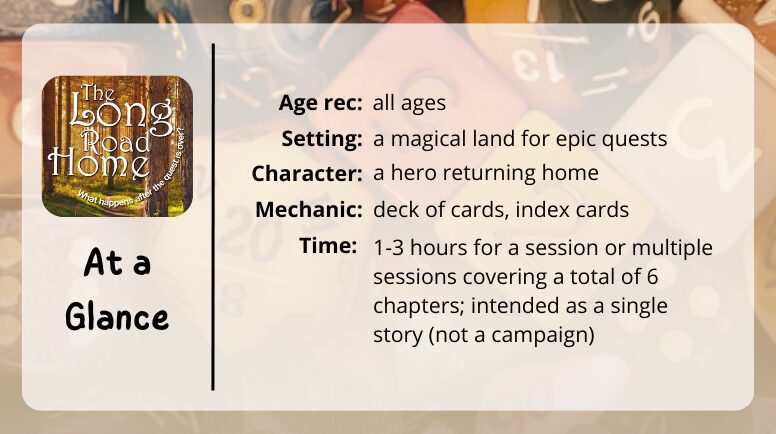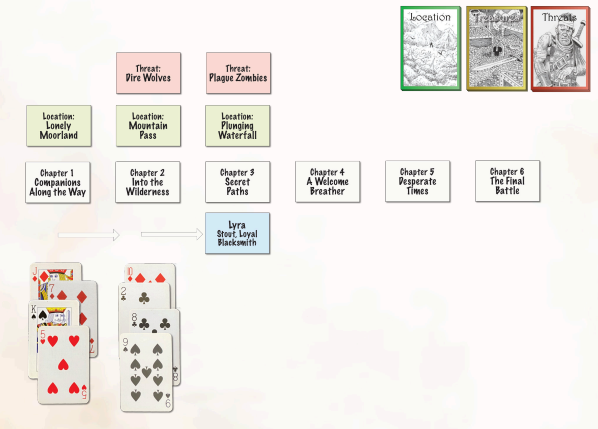Review of The Long Road Home, an epic storytelling game
Note: This post may contain affiliate links. At no additional cost to you, I may earn a small commission from purchases made using them. TTRPGkids uses this to keep the site going. Read full disclosure here.
Jump to:

Age target for The Long Road Home
The Long Road Home is playable at any age and accomodates a wide range of scenarios by means of the genres it facilitates. In this game, you’ll pick a genre to play in, and one of those options is the kid-friendly genre, leaning towards themes in stories like Narnia, The Hobbit (versus The Lord of the Rings), and potentially even something like one of the Pokemon movies or longform superhero stories, depending on what your kid is into.
This is also VERY playable for general audiences as well, providing roll tables, tropes, ect for not just the kid-friendly settings but for everything ranging from young adult (like Percy Jackson) to more grim stories (like Game of Thrones).
With regards to the mechanics accessibility, The Long Road Home is primarily narrative based, and directions for the narrative are determined by interpreting the suit on drawn playing cards. There’s no math skills required, so this won’t barrier to play, however, being able to read would be helpful. If reading is a concern, this can also be easily overcome by having a designated reading helper to assist with using the game’s index cards or reminding of some of the topics on the character sheet during play.
Setting for The Long Road Home

I mentioned before that The Long Road Home tapped into several different genres for the style of adventure that would be played – it also encourages using a wide variety of fantasy settings, so long as they allow players to have this awesomely epic quest.
A big part of the game is creating the setting as a group before you dig into the story, which is a fantastic way of building in group consent and esentially walking through a very solid session zero while making a world for your adventures.
You’ll all choose the genre together, then you’ll pick your realm, your world’s magic system, and some of the locations present. Then you choose your big end game enemy or challenge that you’ll face!
You’ll also populate your story with treasures, NPCs, and events during this time, further building the base for your tale. These elements are all written down on notecards that you’ll use during gameplay… even if you don’t quite know how they’ll fit into the story yet. They are peices of the puzzle, and you’ll put them together later, as you form each part of your individual and group accounts.
I particularly liked this part of the game since it does build in a ton of consent between players as you all agree on the tone, and it is excellent practice for everyone in the group to plan out stories and be part of the creative process. There is no GM, so everyone gets a turn at world generation, and everyone is supporting each other by making suggestions or discussing throughout the whole process.
Your character in The Long Road Home

Your character in The Long Road Home is created after you’ve determined your setting, and they’re fleshed out using a wonderful list of backstory and motive building questions that fit all on one page.
Your character sheet is all about their story – there are no stats to track.
And they can be anyone you want, so long as they fit with the group’s agreed setting! You’ll also continue to build them and make their story increasingly meaningful as you play and discover their unique perspectives on each of the game’s chapters.
Mechanics in The Long Road Home
The Long Road Home uses a deck of cards and your index cards from set up to provide you with a base for story creation.
The epic is broken into six chapters, each with a framing guide in this game showing you how to set up a particular part of a typical journey-focused story (like forming the party, handling classic ups or downs, the final battle, etc).
During these chapters, you’ll have time to describe what your individual character does and what the group does or percieves, but you aren’t entirely left to your own devices to come up with this all from scratch. You’ll be pulling a card from the deck each time it is your turn to add to the story, and the suit of this card will determine the twist that it takes.
Cards tell you if this particular part of your journey was more emotional focused, if you found treasure (and get to draw from your index cards!), was impacted by NPCs in a positive or negative way, and more. They give you a general direction, and you create the rest of the story from there.

My favorite part of this was when it came to the group narration because, even though you are describing a particular event that you all experienced, each person still draws their own card. So, one person might have walked away from that event feeling betrayed while another person, during that exact same event, discovered some kind of inner strength through adversity. It’s an excellent method to show how different people grow and learn and see things in different ways even if they have similar inputs or are in the same space. It was a great storytelling device and a great teaching device about perspectives and empathy as well.
Overall thoughts on The Long Road Home
I really liked this. There’s exciting stories being told, everyone is involved, the mechanics are easy to follow with fantastic walkthroughs, and there are a TON of worldbuilding aides (ranging from tables to descriptions of how to incorporate dozens of different tropes into your storytelling).
There’s examples and reference material to draw from too. I am a very experience and example based learner, and I don’t always see play-by-plays in the games that I try, which can make it hard to work out some of the mechanics. This, however, gave very clear and concise actual-play-like walkthroughs right next to the explanations so I was able to immediately understand what was being described.
The Long Road Home also includes so many other aides! From the references lists to a full actual play at the end (not just excerpts next to the descriptions) to starting maps and NPC generators… this is great for both the game itself and as a world building guide for any system or story that you want to create.
I greatly enjoyed checking this out, and I hope you do too!
Find a copy of The Long Road Home
You can find a copy of The Long Road Home on DriveThruRPG!

If you liked this post, make sure to subscribe to the TTRPGkids monthly newsletter to stay up to date on the latest reviews, tips and tricks, game and podcast list updates, and more! Thank you for playing tabletop RPGs with your kids and sharing this awesome hobby with the next generation!


